Myths & Facts - Boundaries
“The creation of Israel in 1948 changed political and border arrangements between independent states that had existed for centuries.”
“Israel has been an expansionist state since its creation.”
“Israel has long sought to conquer Arab lands stretching from the Nile to the Euphrates. There is even a map hanging in the Knesset documenting this.”
“The West Bank is part of Jordan.”
“Israel seized the Golan Heights in a war of aggression.”
“The Golan has no strategic significance for Israel.”
“Israel has refused to offer any compromises on the Golan Heights while Syria has been willing to trade peace for land.”
“Israel illegally annexed the Golan Heights in 1981, contravening international law and UN Resolution 242.”
“Israel can withdraw from the West Bank with little more difficulty than was the case in Sinai.”
“The Gulf War proves that Israel's demands for defensible borders are unrealistic in an era of ballistic missiles and long-range bombers capable of crossing vast amounts of territory in minutes.”
“Israel ‘occupies’ the West Bank.”
“The demographic threat to Israel posed by Arabs in the West Bank and Gaza is overrated and therefore Israel need not make territorial compromises.”
“The creation of Israel in 1948 changed political and border arrangements between independent states that had existed for centuries.”
FACT
The boundaries of Middle East countries were arbitrarily fixed by the Western powers after Turkey was defeated in World War I and the French and British mandates were set up. The areas allotted to Israel under the UN partition plan had all been under the control of the Ottomans, who had ruled Palestine from 1517 until 1917.
When Turkey was defeated in World War I, the French took over the area now known as Lebanon and Syria. The British assumed control of Palestine and Iraq. In 1926, the borders were redrawn and Lebanon was separated from Syria.
Britain installed the Emir Faisal, who had been deposed by the French in Syria, as ruler of the new kingdom of Iraq. In 1922, the British created the emirate of Transjordan, which incorporated all of Palestine east of the Jordan River. This was done so that the Emir Abdullah, whose family had been defeated in tribal warfare in the Arabian peninsula, would have a Kingdom to rule. None of the countries that border Israel became independent until the Twentieth Century. Many other Arab nations became independent after Israel.1
“Israel has been an expansionist state since its creation.”
FACT
Israel's boundaries were determined by the United Nations when it adopted the partition resolution in 1947. In a series of defensive wars, Israel captured additional territory. On numerous occasions, Israel has withdrawn from these areas.
As part of the 1974 disengagement agreement, Israel returned territories captured in the 1967 and 1973 wars to Syria.
Under the terms of the 1979 Israeli-Egyptian peace treaty, Israel withdrew from the Sinai peninsula for the third time. It had already withdrawn from large parts of the desert area it captured in its War of Independence. After capturing the entire Sinai in the 1956 Suez conflict, Israel relinquished the peninsula to Egypt a year later.
In September 1983, Israel withdrew from large areas of Lebanon to positions south of the Awali River. In 1985, it completed its withdrawal from Lebanon, except for a narrow security zone just north of the Israeli border. That too was abandoned, unilaterally, in 2000.
After signing peace agreements with the Palestinians, and a treaty with Jordan, Israel agreed to withdraw from most of the territory in the West Bank captured from Jordan in 1967. A small area was returned to Jordan, and more than 40 percent was ceded to the Palestinian Authority. The agreement with the Palestinians also involved Israel's withdrawal in 1994 from most of the Gaza Strip, which had been captured from Egypt in 1973.
Israeli Prime Minister Ehud Barak offered to withdraw from 95 percent of the West Bank and 100 percent of the Gaza Strip in a final settlement. In addition, Prime Minister Yitzhak Rabin and his successors offered to withdraw from virtually all of the Golan Heights in exchange for peace with Syria.
As part of the Oslo agreements, Israel withdrew from more than 40 percent of the West Bank and approximately 80 percent of the Gaza Strip. Israel is now preparing to evacuate all Jewish residents and disengage from the entire Gaza Strip. When that process is complete, Israel will have withdrawn from approximately 94 percent of the territory it captured in 1967.
Negotiations continue regarding the final disposition of the remaining 6 percent (about 1,600 square miles) of the disputed territories in Israel's possession. Israel's willingness to make territorial concessions in exchange for security proves its goal is peace, not expansion.
“Israel has long sought to conquer Arab lands stretching from the Nile to the Euphrates. There is even a map hanging in the Knesset documenting this.”
FACT
This theme is frequently used by Israel's enemies, and is routinely repeated throughout the Arab and Islamic worlds.
In Iran, a map purporting to show Israel's "dream" boundaries ? an empire including Saudi Arabia, Iraq, Kuwait, and parts of Turkey and Iran ? was included in a 1985 reprint of the Protocols of the Elders of Zion, the notorious Czarist forgery.
At a May 25, 1990, press conference in Geneva, Yasser Arafat claimed Israel's 10-Agora coin depicts a map of an enlarged Israel, which included all of Jordan and Lebanon, as well as large portions of Iraq, Syria, Saudi Arabia and Egypt.
In fact, the Agora is patterned after an ancient Jewish coin issued at the time of King Mattathias of the Hasmonean dynasty. The modern Israeli version depicts the shape of the original coin, which had eroded during the ensuing 2,000 years. It is this deformed shape of an ancient coin that Arafat asserted represents a secret "map" of an expansionist Israel.
Syrian Defense Minister Mustafa Tlas has said that an inscription, "The Land of Israel, from the Euphrates to the Nile," is chiseled over the entrance to the Knesset.2 Others have claimed a map inside the Knesset shows these borders.
No such inscription or map exists. But many in the Arab world have persuaded themselves it is true. Arabs who have toured the parliament and not seen the map sometimes claim it was removed in anticipation of their visit.3
Of course, the best evidence against this myth is the history of Israeli withdrawal from territory captured in 1948, 1956, 1967, 1973 and 1982.
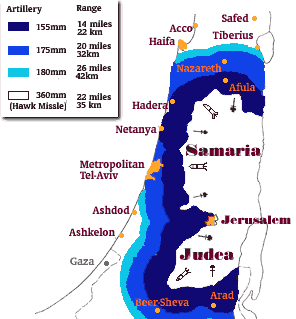
“The West Bank is part of Jordan.”
FACT
The West Bank was never legally part of Jordan. Under the UN's 1947 partition plan ? which the Jews accepted and the Arabs rejected ? it was to have been part of an independent Arab state in western Palestine. But the Jordanian army invaded and occupied it during the 1948 war. In 1950, Jordan annexed the West Bank.
Only two governments ? Great Britain and Pakistan ? formally recognized the Jordanian takeover. The rest of the world, including the United States, never did.
“Israel seized the Golan Heights in a war of aggression.”
FACT
Between 1948 and 1967, Syria controlled the Golan Heights and used it as a military stronghold from which its troops randomly sniped at Israeli civilians in the Hula Valley below, forcing children living on kibbutzim to sleep in bomb shelters. In addition, many roads in northern Israel could be crossed only after being cleared by mine-detection vehicles. In late 1966, a youth was blown to pieces by a mine while playing football near the Lebanon border. In some cases, attacks were carried out by Yasser Arafat's Fatah, which Syria allowed to operate from its territory.4
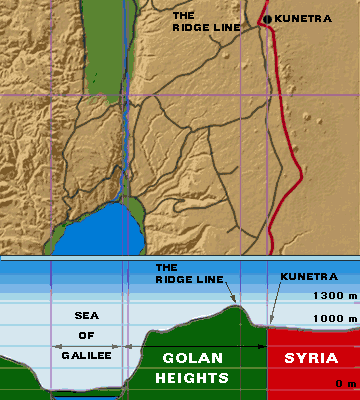
Israel repeatedly, and unsuccessfully, protested the Syrian bombardments to the UN Mixed Armistice Commission, which was charged with enforcing the cease-fire. For example, Israel went to the UN in October 1966 to demand a halt to the Fatah attacks. The response from Damascus was defiant. "It is not our duty to stop them, but to encourage and strengthen them," the Syrian ambassador responded.5
Nothing was done to stop Syria's aggression. A mild Security Council resolution expressing "regret" for such incidents was vetoed by the Soviet Union. Meanwhile, Israel was condemned by the UN when it retaliated. "As far as the Security Council was officially concerned," historian Netanel Lorch wrote, "there was an open season for killing Israelis on their own territory."6
After the Six-Day War began, the Syrian air force attempted to bomb oil refineries in Haifa. While Israel was fighting in the Sinai and West Bank, Syrian artillery bombarded Israeli forces in the eastern Galilee, and armored units fired on villages in the Hula Valley below the Golan Heights.
On June 9, 1967, Israel moved against Syrian forces on the Golan. By late afternoon, June 10, Israel was in complete control of the plateau. Israel's seizure of the strategic heights occurred only after 19 years of provocation from Syria, and after unsuccessful efforts to get the international community to act against the aggressors.
“The Golan has no strategic significance for Israel.”
FACT
It is true that Syria ? deterred by an IDF presence within artillery range of Damascus ? has kept the Golan quiet since 1974. But during this time, Syria has provided a haven and supported numerous terrorist groups that attack Israel from Lebanon and other countries. These include the Democratic Front for the Liberation of Palestine (DFLP), the Popular Front for the Liberation of Palestine (PFLP), Hizbollah and the Popular Front for the Liberation of Palestine-General Command (PFLP-GC). In addition, Syria still deploys hundreds of thousands of troops ? as much as 75 percent of its army ? on the Israeli front near the Heights.
From the western Golan, it is only about 60 miles ? without major terrain obstacles ? to Haifa and Acre, Israel's industrial heartland. The Golan ? rising from 400 to 1700 feet in the western section bordering on pre?1967 Israel ? overlooks the Hula Valley, Israel's richest agricultural area. In the hands of a friendly neighbor, the escarpment has little military importance. If controlled by a hostile country, however, the Golan has the potential to again become a strategic nightmare for Israel.
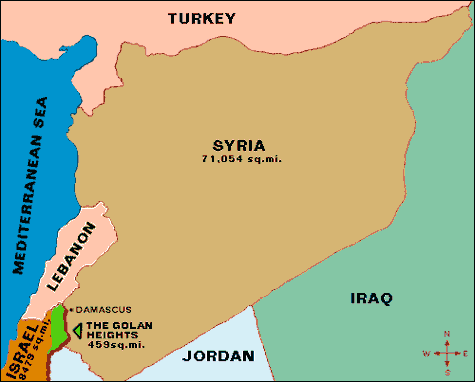
Before the Six-Day War, when Israeli agricultural settlements in the Galilee came under fire from the Golan, Israel's options for countering the Syrian attacks were constrained by the geography of the Heights. "Counterbattery fires were limited by the lack of observation from the Huleh Valley; air attacks were degraded by well-dug-in Syrian positions with strong overhead cover, and a ground attack against the positions...would require major forces with the attendant risks of heavy casualties and severe political repercussions," U.S. Army Col. (Ret.) Irving Heymont observed.7
When Israel eventually took these risks and stormed the Syrian positions in 1967, it suffered 115 dead ? roughly the number of Americans killed during Operation Desert Storm.
As the peace process faltered in the late 1990's, Syria began to renew threats of war with Israel and to make threatening troop movements. Some Israeli analysts have warned of the possibility of a lightning strike by Syrian forces aimed at retaking the Golan. The Israeli Defense Forces have countered the Syrian moves, however, and ? to this point ? preserved the peace.
For Israel, relinquishing the Golan to a hostile Syria without adequate security arrangements could jeopardize its early-warning system against surprise attack. Israel has built radar systems on Mt. Hermon, the highest point in the region. If Israel withdrew from the Golan and had to relocate these facilities to the lowlands of the Galilee, they would lose much of their strategic effectiveness.
Israeli Settlements in the Golan Heights (February 1992)
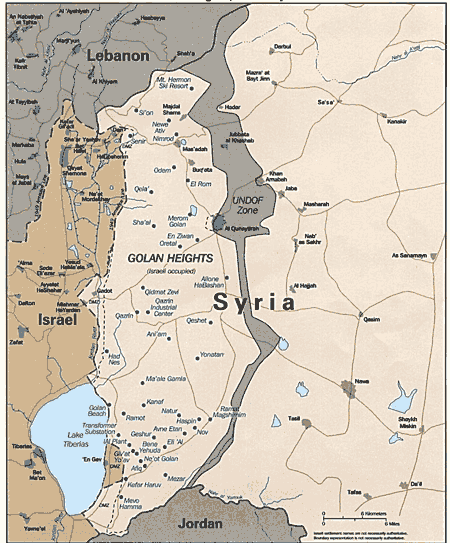
“Israel has refused to offer any compromises on the Golan Heights while Syria has been willing to trade peace for land.”
FACT
Under Hafez Assad, Syria's position was consistent: Israel must completely withdraw from the entire Golan Heights before he would entertain any discussion of what Syria might do in return. He never expressed any willingness to make peace with Israel if he received the entire Golan or any part of it.
Israel has been equally adamant that it would not give up any territory without knowing what Syria was prepared to concede. Israel's willingness to trade some or all of the Golan is dependent on Syria's agreement to normalize relations and to sign an agreement that would bring about an end to the state of war Syria says exists between them.
The topographical concerns associated with withdrawing from the Golan Heights could be offset by demilitarization, but Israel needs to have a defensible border from which the nation can be defended with minimum losses. The deeper the demilitarization, and the better the early warning, the more flexible Israel can be regarding that border.
In addition to military security, Israelis seek the normalization of relations between the two countries. At a minimum, ties with Syria should be on a par with those Israel has with Egypt; ideally, they would be closer to the type of peace Israel enjoys with Jordan. This means going beyond a bare minimum of an exchange of ambassadors and flight links and creating an environment whereby Israelis and Syrians will feel comfortable visiting each other's country, engaging in trade and pursuing other forms of cooperation typical of friendly nations.
In the meantime, substantial opposition exists within Israel to withdrawing from the Golan Heights. The expectation of many is that public opinion will shift if and when the Syrians sign an agreement and take measures, such as reigning in Hizballah attacks on Israel from southern Lebanon, that demonstrate a genuine interest in peace. And public opinion will determine whether a treaty is concluded because of a law adopted during Prime Minister Netanyahu's term that requires any agreement to be approved in a national referendum.
President Hafez Assad died in June 2000 and there have not been any negotiations since, as Assad's son and successor, Bashar, has moved to consolidate his power in Syria. Rhetorically, Bashar has not indicated any shift in Syria's position on the Golan. Absent dramatic changes in Syria's government and its attitude toward Israel; however, the Jewish State's security will depend on its retention of military control over the Golan Heights.
| “From a strictly military point of view, Israel would require the retention of some captured territory in order to provide militarily defensible borders.” ?Memorandum for the Secretary of Defense |
“Israel illegally annexed the Golan Heights in 1981, contravening international law and UN Resolution 242.”
FACT
On December 14, 1981, the Knesset voted to annex the Golan Heights. The statute extended Israeli civilian law and administration to the residents of the Golan, replacing the military authority that had ruled the area since 1967. The law does not foreclose the option of negotiations on a final settlement of the status of the territory.
Following the Knesset's approval of the law, Professor Julius Stone of Hastings College of the Law wrote: "There is no rule of international law which requires a lawful military occupant, in this situation, to wait forever before [making] control and government of the territory permanent....Many international lawyers have wondered, indeed, at the patience which led Israel to wait as long as she did."8
“Israel can withdraw from the West Bank with little more difficulty than was the case in Sinai.”
FACT
Several pages of Israel's peace treaty with Egypt are devoted to security arrangements. For example, Article III of the treaty's annex concerns the areas where reconnaissance flights are permitted, and Article V allows the establishment of early-warning systems in specific zones.
The security guarantees, which were required to give Israel the confidence to withdraw, were only possible because the Sinai was demilitarized. They provide Israel a large buffer zone of more than 100 miles. Today, the Egyptian border is 60 miles from Tel Aviv and 70 from Jerusalem, the nearest major Israeli cities. The Sinai remains sparsely populated desert, with a population of less than 250,000.
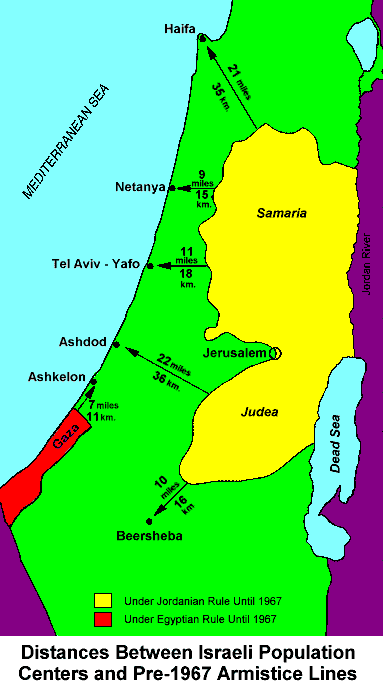
The situation in the territories is entirely different. More than two million Arabs live in the West Bank, many in crowded cities and refugee camps. Most of them are located close to Israeli cities such as Tel Aviv and Jerusalem. It is important for Israel that the West Bank not fall into the hands of hostile neighbors. The infiltration in recent years of terrorists from the Palestinian Authority who have committed horrific acts such as suicide bombings illustrate the danger.
Despite the danger, Israel has withdrawn from more than 40 percent of the West Bank since Oslo, and offered to give up 95 percent of it in return for a final settlement with the Palestinians. Israel will not, and cannot, however, go back to the pre-1967 borders as demanded by the Palestinians and the Arab states.
The agreements Israel has signed with the Palestinians, and the treaty with Jordan, contain many specific provisions designed to minimize the security risks to Israel. The violence of the "al-Aqsa intifada," however, has shown that the Palestinians are not prepared to fulfill their signed commitments to prevent terrorism and incitement.
| “It is impossible to defend Jerusalem unless you hold the high ground....An aircraft that takes off from an airport in Amman is going to be over Jerusalem in two-and-a-half minutes, so it's utterly impossible for me to defend the whole country unless I hold that land.” ?Lieutenant General (Ret.) Thomas Kelly, |
“The Gulf War proves that Israel's demands for defensible borders are unrealistic in an era of ballistic missiles and long-range bombers capable of crossing vast amounts of territory in minutes.”
FACT
History shows that aerial attacks have never defeated a nation. Countries are only conquered by troops occupying land. The most recent example of this was Iraq's invasion of Kuwait, in which the latter nation was overrun and occupied in a matter of hours. Though the multinational force bombed Iraq for close to six weeks, Kuwait was not liberated until the Allied troops marched into that country in the war's final days. Defensible borders are those that would prevent or impede such a ground assault.
Israel's return to its pre-1967 borders, which the Arab states want to reimpose, would sorely tempt potential aggressors to launch attacks on the Jewish State ? as they did routinely before 1967. Israel would lose the extensive system of early-warning radars it has set up in the hills of Judea and Samaria. Were a hostile neighbor then to seize control of these mountains, its army could split Israel in two: From there, it is only about 15 miles ? without any major geographic obstacles ? to the Mediterranean.
At their narrowest point, these 1967 lines are within 9 miles of the Israeli coast, 11 miles from Tel Aviv, 10 from Beersheba, 21 from Haifa and one foot from Jerusalem.
In 1989, the Jaffee Center for Strategic Studies, an Israeli think tank considered dovish, wrote:
The introduction of surface-to-surface missiles into the arena sometimes gives rise to the question of whether the concepts of strategic depth and security arrangements remain meaningful in this new era. The answer is an unequivocal yes. Early-warning stations and the deployment of surface-to-air missile batteries can provide the time needed to sound an air-raid alert, and warn the population to take shelter from a missile attack. They might even allow enemy missiles to be intercepted in mid-flight.
The study concluded: "As long as such missiles are armed with conventional warheads, they may cause painful losses and damage, but they cannot decide the outcome of a war."10
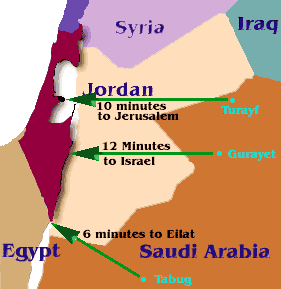
In a report to the Secretary of Defense in 1967, the U.S. Joint Chiefs of Staff wrote that, at a minimum, "Israel would need a defense line generally along the Bardala-Tuba-Nablus-Bira-Jerusalem axis, and then to the northern part of the Dead Sea. This line would widen the narrow portion of Israel and provide additional terrain for the defense of Tel Aviv."
The report also provides support for a united Jerusalem under Israeli control. To defend Jerusalem, the Joint Chiefs concluded, Israel would need to have its border "positioned to the east of the city."11
| “For a Texan, a first visit to Israel is an eye-opener. At the narrowest point, it's only 8 miles from the Mediterranean to the old Armistice line: That's less than from the top to the bottom of Dallas-Ft. Worth Airport. The whole of pre-1967 Israel is only about six times the size of the King Ranch near Corpus Christi.” ? President George W. Bush)12 |



